[
Kangpokpi/Imphal, India – On Christmas Eve, it was eerily calm inside a makeshift bunker with piles of gunny luggage and a tin roof. Hunkered inside and clutching their single-barrelled rifles, 19-year-old Chonminlal Kipgen and 26-year-old Paolal Kipgen from the predominantly Christian Kuki-Zo neighborhood regarded out and scoured the hills of Kangpokpi district for armed fighters from the rival Meitei neighborhood.
They stated they have been village volunteers – civilians who had taken up arms to defend their properties.
Not so distant in Manipur’s capital, Imphal, the majority-Meitei neighborhood had equally muted celebrations throughout their most cherished competition, Ningol Chakouba, in early November.
For the previous 11 months, the 2 communities in India’s northeastern state of Manipur have been locked in what’s arguably the nation’s longest-running ethnic battle within the twenty first century underneath the watch of a federal authorities headed by Prime Minister Narendra Modi.
The battle has killed 219 individuals, injured 1,100 and displaced 60,000. It has revived an array of armed teams, sweeping up males and boys as recruits from each communities. On Saturday, two Kuki-Zo “village volunteers” have been killed and their our bodies allegedly mutilated in Manipur’s Kangpokpi district. Of their press launch, tribal teams accused “central safety forces, who aided Meitei militants” of being behind the killings.
The battle is continuously oversimplified as a wrestle between the Hindu Meitei and Christian Kuki-Zo communities, mirroring the spiritual polarisation seen in communal conflicts and assaults on spiritual minorities in varied components of India. Whereas the Kuki-Zo communities are virtually totally Christian, the Meitei neighborhood predominantly follows a syncretic type of Hinduism and their very own Indigenous religion system, known as Sanamahism. A smaller variety of Meitei individuals additionally comply with Christianity and Islam.
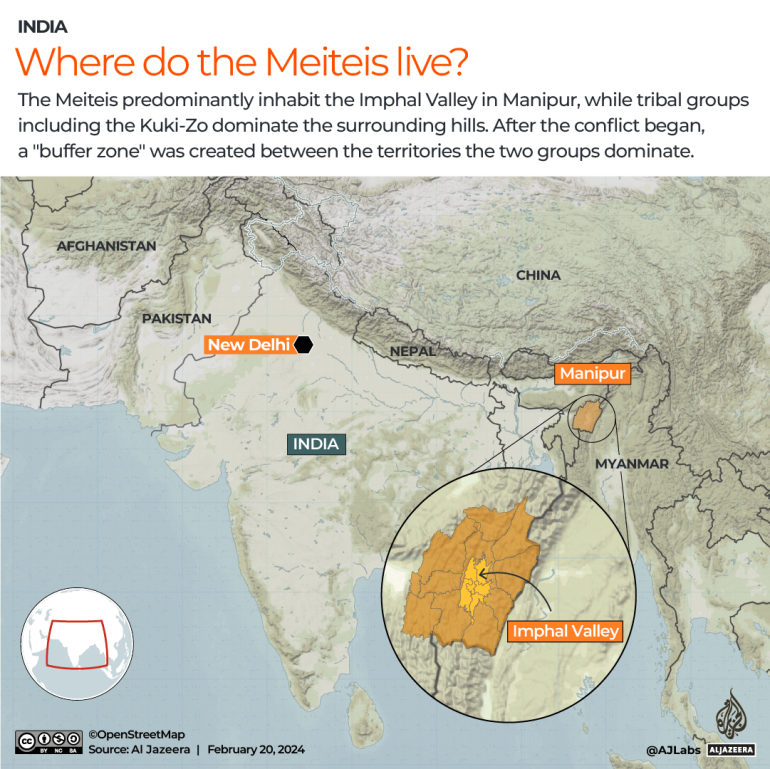
However an evaluation ready by Assam Rifles officers in Manipur highlighted a special set of things which might be distinctive to the battle in Manipur. The Assam Rifles is the federal authorities’s paramilitary drive with a protracted and controversial historical past within the state. It’s the oldest paramilitary drive within the nation and shoulders the duty of sustaining legislation and order within the northeast together with the military.
The Reporters’ Collective (TRC) reviewed the evaluation, made in a PowerPoint presentation, late in 2023. The officers who confirmed the presentation wished to stay nameless. They took me via the presentation, which was in sync with the views one of many officers shared with me whereas explaining the explanations behind the Manipur battle.
The presentation put a part of the blame on the state authorities, headed by Chief Minister N Biren Singh, a member of Modi’s Hindu nationalist Bharatiya Janata Occasion (BJP), and his “political authoritarianism and ambition”.
It’s the first candid evaluation from a federal authorities company that has made it into the general public area.
It’s vital as a result of Modi this month, within the run-up to a common election, had asserted that the federal authorities’s well timed intervention had led to a “marked enchancment within the state of affairs” in Manipur. This was one of many few instances that the prime minister had spoken of the battle. In the meantime, the federal residence affairs minister has positioned his religion within the chief minister’s capability to convey peace, which to date has not supplied a decision. The state’s two seats in India’s decrease home of parliament vote on April 19 and April 26, within the first two phases of the nationwide elections.
The evaluation by the Assam Rifles listed causes of the battle as decided by officers within the thick of the violence.
It highlighted the influence of “unlawful immigrants” from neighbouring Myanmar, the resultant demand for a nationwide register of residents to cut back migration and the demand for Kukiland.
Kukiland is a separate administrative unit that the political and armed Kuki management needs cleaved out of Manipur. The demand for Kukiland has been revived in the course of the ethnic battle.
Moreover, the presentation asserted that armed teams from the Meitei neighborhood are equipping individuals with weapons, and the Kuki neighborhood’s armed teams are backing “volunteers”.
All of this has intensified tensions and contradicted makes an attempt by each communities’ leaders to current the battle as frequent residents volunteering for self-defence towards the opposite neighborhood.
TRC couldn’t independently confirm if the views within the presentation are endorsed by the Assam Rifles as an organisation. Detailed questions have been despatched to the paramilitary drive’s official spokesperson.
Initially, a spokesperson stated the Assam Rifles wouldn’t have the ability to reply to one thing that was “rumour”.
In a follow-up e mail, the Assam Rifles stated it will “respectfully decline to have interaction in discussions concerning speculative or unverified issues. As knowledgeable establishment, we concentrate on our core duties and obligations, and we’ve no additional feedback on this concern presently.” Later, it requested for a replica of the presentation.
The Assam Rifles didn’t reply to TRC’s follow-up emails asking if it held the views mirrored within the presentation.
Queries to the Ministry of Residence Affairs and the Manipur chief minister’s workplace stay unanswered.
The chief minister’s position

The rapid set off for the violence was a requirement by the dominant Meitei neighborhood for Scheduled Tribe standing, a type of affirmative motion granting quotas of presidency jobs and school admissions. It was opposed by different tribal teams, together with these from the Kuki-Zo neighborhood.
However within the presentation, Assam Rifles officers pointed to insurance policies of the chief minister that they believed fed the animosity between the communities. It famous Singh’s “arduous stance” on the “struggle on medicine” and “vocal social media dissent”, amongst different issues, for inflaming the battle.
The presentation accused Singh of making divisions between communities within the state’s marketing campaign to cease medicine from being manufactured, traded and offered in Manipur. His forceful drive towards the cultivation of poppies, grown in hilly areas of the state bordering Myanmar, drove residence the impression that he’s concentrating on Kukis.
The presentation additionally cited “state forces’ tacit help” of the violence and the “dismemberment of law-and-order equipment”.
One other issue within the battle, the presentation famous, is “Meitei Revivalism”. Revivalism refers back to the lengthy historical past of the Meitei neighborhood aspiring to revert to its id earlier than the appearance of Hinduism within the 18th century and later the merger of Manipur into India in 1949. The marketing campaign led to a revival of Sanamahism within the Thirties and fuelled the armed actions subsequently.
The presentation lists Meitei Leepun and Arambai Tenggol, two Meitei organisations, as among the many components that has fuelled the battle.
Arambai Tenggol was shaped in 2020 “underneath the aegis of the titular king of Manipur and BJP Member of Parliament Leishemba Sanajaoba”, a police officer informed me.
The Tenggol was initially shaped as a sociocultural organisation targeted on the revival of Sanamahi tradition and later took up arms. It earned a extra vigilante-like fame in April final yr after it broke into the home of a Meitei Christian pastor who had allegedly insulted the Sanamahism religion.
The Arambai Tenggol is helmed by Tyson Ngangbam, who goes by the pseudonym “Korounganba Khuman”. (Korounganba is a standard Meitei identify which means “sunshine” whereas Khuman is the identify of a clan.)
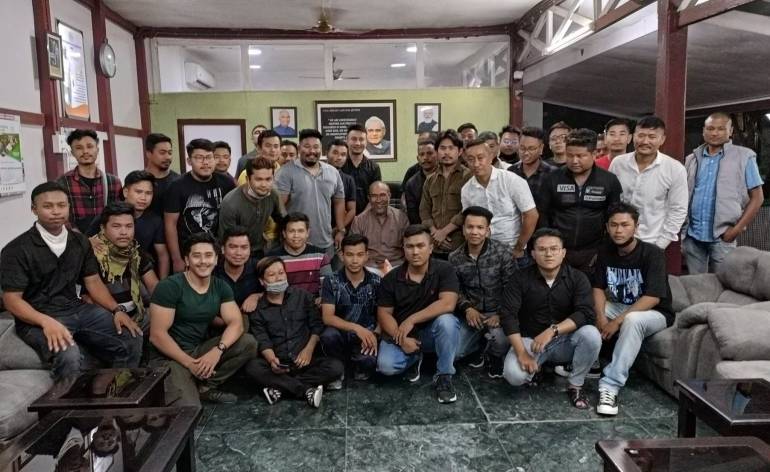
TRC despatched inquiries to Ngangbam via his social media account, which he has used in the course of the battle. The report might be up to date if he responds.
In January, in a present of power, Arambai Tenggol summoned 37 members of Manipur’s Legislative Meeting and two members of parliament from the state, together with RK Ranjan Singh, the federal minister of state for exterior affairs and schooling, for a gathering at Kangla Fort, the palace of the Meitei kings within the coronary heart of Imphal. It included lawmakers from the Meitei neighborhood throughout celebration strains.
Ngangbam spelled out the group’s calls for, together with updating the Nationwide Register of Residents, a course of by which the Indian authorities hopes to establish and exclude undocumented migrants.
The group additionally demanded abrogation of the Suspension of Operation – a peace settlement – with the Kuki-Zo armed teams, the relocation of refugees from Myanmar to the neighbouring state of Mizoram, border fencing alongside the Indo-Myanmar border, the withdrawal of the Assam Rifles from Manipur and the delisting of “unlawful migrants” from the Scheduled Tribes listing – a transfer that will exclude Kuki-Zo individuals from Myanmar from accessing the Indian authorities’s affirmative motion insurance policies. The lawmakers dedicated to again the calls for.
Meitei Leepun, which can be of latest origin, is perceived as influenced by the ideology of Rashtriya Swayamsevak Sangh (RSS), the fountainhead of a spectrum of hardline Hindu organisations, together with the BJP. The chief of Meitei Leepun brazenly professes allegiance to the state’s chief minister and BJP chief Biren Singh, a Meitei.
Each Meitei Leepun and Arambai Tenggol face accusations from Kuki leaders of spearheading assaults by the Meitei neighborhood towards their individuals. Whereas Arambai Tenggol leans in direction of a stronger Meitei nationalist stance distinct from Hinduism, Meitei Leepun aligns with the Hindutva marketing campaign led by the RSS and BJP.
A Meitei Leepun chief, Pramot Singh, informed me: “We (the Meiteis) are followers of sanatana dharma. … If Meitei turns into extinct, the final outpost of sanatana dharma in Manipur is gone in the identical method Kashmiri Pandits are gone.”
Pramot Singh was referring to an upper-caste Brahmin group that lived in Kashmir however was compelled to flee within the Nineties as they confronted persecution and threats of violence by Kashmiri armed teams.
The Revivalists, in distinction, see Meiteis as distinct from the remainder of India with their very own cultural and spiritual id and an erstwhile Manipuri kingdom known as Kangleipak, which was merged by coercion into India in 1949.
The Assam Rifles presentation was silent on the political and enterprise underpinnings of the battle, the position of the federal authorities – underneath the BJP – and the Assam Rifles’ personal failings and alleged bias.
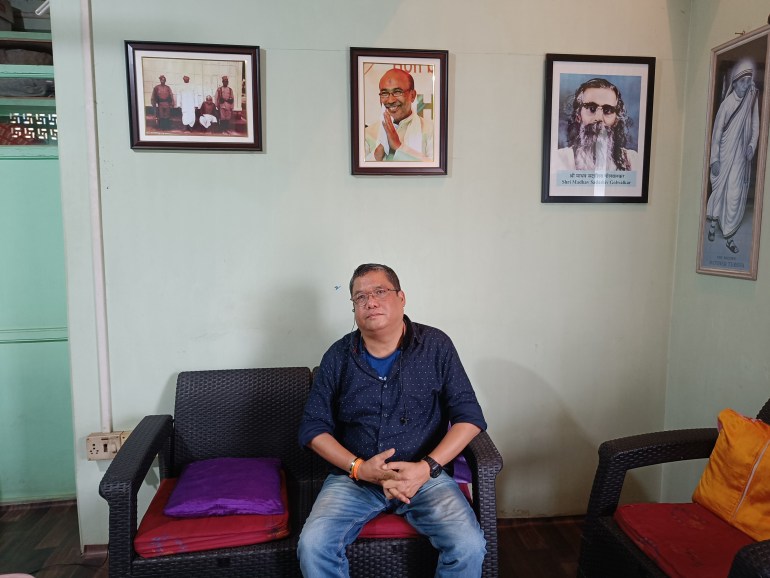
In line with the Assam Rifles presentation, the battle is split into three phases: “provoke”, “mutate” and “stalemate”. It laid out how the character and character of the violence have modified via these levels.
My reporting over six months helped draw out particulars of what the paramilitary drive’s presentation talked about and what it neglected.
The initiation
The embers of the present battle – Biren Singh’s alleged political authoritarianism, arduous stance on poppy cultivation, undocumented immigration, demand for Kukiland and Meitei Revivalism – have lengthy smouldered.
However in April final yr got here the spark that ignited the simmering pressure. This era was referred to by the Assam Rifles presentation as “provoke”.
That month, the Manipur Excessive Court docket had requested the state authorities to think about petitions for together with the Meitei neighborhood within the listing of Scheduled Tribes – the constitutional provision that within the case of Manipur consists of property possession within the hilly areas dominated by Kukis. The Manipur Land Income and Land Reforms Act of 1960 permits solely Scheduled Tribes to purchase land within the hill areas.
Heeding a name by the All Tribal College students’ Union Manipur, the main tribal civil society organisation in Manipur, for a “solidarity march” within the hill districts the place tribal communities dominate, rallies have been held on Might 3 in Senapati, Ukhrul, Kangpokpi, Tamenglong, Churachandpur, Chandel and Tengnoupal.
Because the march was winding up within the city of Churachandpur, information unfold {that a} tyre had been set on hearth in entrance of the Anglo-Kuki Centenary Gate, which was constructed to commemorate the 1917-1919 Kuki rebellion towards the British.
Subsequently, a gaggle of younger individuals approached the gate wielding weapons. Quickly, phrase unfold, suggesting that “militants” have been upsetting the group, Outlook journal reported. Inside a few hours, rumours unfold via the state that Kuki mobs have been vandalising Meitei homes.
The Assam Rifles officers’ presentation stated the interval of battle beginning Might 3 was characterised by “excessive depth riots”, “selective concentrating on” and it was “orchestrated and led by militias”.
Mobs ran amok within the cities, notably in Imphal, situated within the valley with a predominantly Meitei inhabitants.
“On the evening of Might 3 at 8pm, individuals carrying black shirts attacked us. We fired blanks, which compelled them to retreat however only for a while,” stated 43-year-old L Ngampao Khongsai, who had been dwelling in Imphal’s Khongsai Veng space, a predominantly Kuki-Zo space.
In line with Khongsai, a Kuki-Zo, the mob continued to assault the neighbourhood regardless of pushback from the safety forces. “They might be saying that Kuki must be killed and threw stones.”
Khongsai fled along with his household and hid at a close-by college. Like 1000’s of others from the valley, he ran and made his method to the Kuki-Zo-dominated Churachandpur district.
Within the hill areas and nearer to the foothills, mobs attacked Meitei neighbourhoods. A pregnant Warepam Rameshwori was compelled to flee her village. “Our village is on the foothills in Tronglaobi Maning Leikai (in Bishnupur district) surrounded by Kuki villages. On Might 3, the firing began. … (The Kukis) had subtle weapons and began firing at us, and we didn’t have any weapons to defend, so we ran away from there and located shelter at a relative’s residence,” she stated.
Seventy-nine Kuki-Zo and 18 Meitei people misplaced their lives from Might 3 to Might 23, based on an Assam Rifles estimate. This era additionally recorded a wave of assaults and looting of arms from police stations. In line with the Assam Rifle evaluation, 5,668 weapons have been looted.
“(The state authorities) allowed the looting of arms. I imply, it’s apparent as a result of it’s inconceivable for individuals to only enter the police stations and take out arms,” a retired police officer acquainted with the safety and intelligence operations within the area informed me.
“So the Meitei civilians and the insurgent teams had gotten weapons and began sustaining vigilance within the city. … In response, the opposite facet felt that the SoO (Suspension of Operations) arms individuals ought to get out and distribute weapons amongst the Kukis,” he stated.
The Suspension of Operations is the peace settlement signed amongst Kuki-Zo armed teams, the federal authorities and the Manipur authorities. The SoO requires Kuki-Zo militias to remain in designated camps and all their weapons be stored within the camp’s central armoury underneath the supervision of the state.
“The divide was full, and that was the stage at first when the political management ought to have cracked down very, very closely,” the officer stated.
That didn’t occur. The battle unfold and mutated, the Assam Rifles presentation famous.
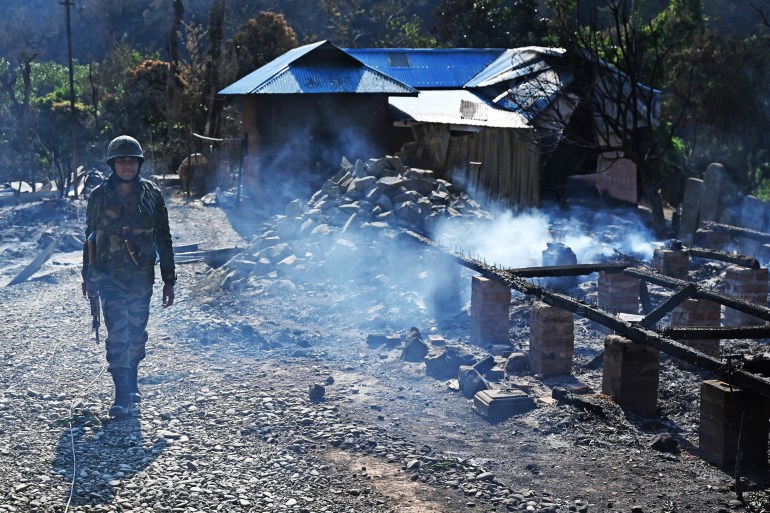
Greater than 8,000 studies
TRC tried to redraw the preliminary interval of the battle by analysing 8,169 first info studies (FIRs) – 5,818 have been filed in Might and a pair of,351 in June.
An FIR is the primary grievance filed both by residents or police, which the police then have to analyze to find out whether or not a criminal offense has been dedicated.
On Might 3, an FIR was filed recording the preliminary set off of the violence between the 2 communities. In line with the FIR filed by the authorities: “An enormous (quantity) of Kuki and Meitei youths numbering about 1,500 clashed amongst one another and vandalised and burned down many homes of each communities at Torbung Bangla. In that, many homes numbering about 300 homes and a few personal autos have been additionally burnt down by the rioters. The police personnel hearth(d) some rounds of tear gasoline smoke bombs and different ammunition to disperse the mob.”
The looting of weapons was reported as beginning on Might 4 with the primary registered incident being reported at Manipur Police Coaching School in Imphal. In line with the FIR, “The big mob overpowered the sentry and broke the lock of arm kote room and looted numerous arms and ammunitions (sic),” together with automated rifles – 157 INSAS rifles, 54 SLR rifles and AK-47 rifles, amongst others. The looting of weapons continued till Might 31, as recorded in these 8,169 FIRs.
Within the first two months of the battle, 7,831 circumstances of vandalism and incidents wherein residents have been compelled to flee have been reported. As well as, 189 circumstances of killings, assaults – together with sexual assault – bodily hurt and lacking individuals, and 79 circumstances of mass looting of weapons have been additionally recorded.
A number of FIRs have been practically equivalent or comparable. For example, on Might 10, 76 FIRs filed within the Sagolmang police station in Imphal East District included an identical grievance: “Some unknown individuals holding arms and lethal weapons numbering about 1,000 suspected to be Kuki Neighborhood from completely different villages entered at (identify of place) and broken the properties in addition to burnt the home.” The one variations within the studies have been the place names and the lists of broken gadgets.
An analogous development was seen within the police complaints filed by the opposing Kuki-Zo facet.
“If a village with 40 households was burnt, there can be 40 complaints,” a second police officer stated on the situation of anonymity. In line with him, the “equivalent” circumstances have been all mixed to assist the inquiry being led by a particular investigative group.
The second part
In line with the Assam Rifles presentation, the character of the battle started to vary on the finish of Might.
That is the time when federal Residence Minister Amit Shah made a four-day journey to Manipur to sew up a truce. By then, the federal authorities, in an unprecedented transfer, had appointed a federal officer in command of all safety and policing operations within the state, bringing the state police and the federal paramilitary and armed forces underneath one command.
The federal authorities could dismiss a state authorities and take over management of the state’s capabilities if it believes “the constitutional equipment” has failed. The structure additionally requires the federal authorities to guard a “state towards exterior aggression and inside disturbance”.
However on this case, the federal authorities stored its religion within the state authorities and didn’t invoke both of those constitutional provisions.
Once more unprecedented, the federal government sought to attain a truce by drawing up an ethnic boundary, calling it a buffer zone, dividing the Kuki-Zo from Meitei-dominated areas and implementing this boundary via its armed forces.
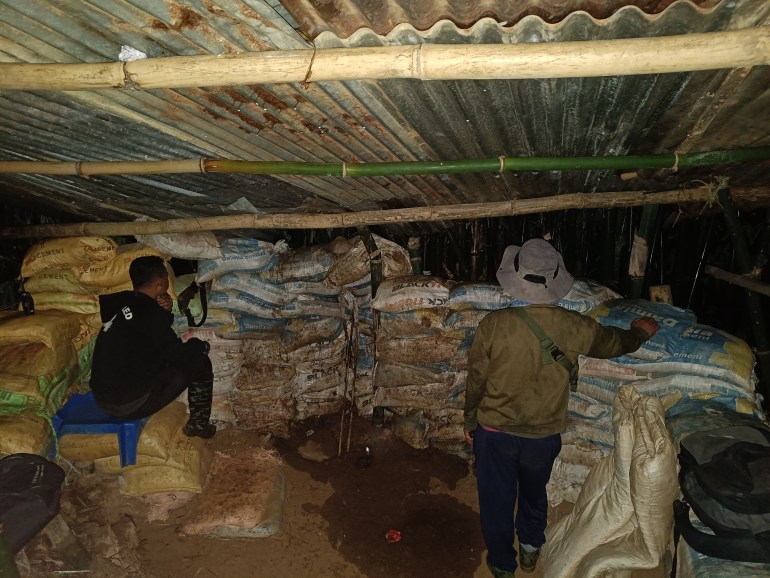
Shah’s go to and the technique to impose a unified federal policing command and the buffer zone failed.
The violence abated in the principle Kuki-Zo or Meitei-dominated cities, nevertheless it shifted to rural areas. These rural areas, stretching from the Imphal Valley to the Kuki-dominated hills, are made up of small hamlets, villages and townships the place Meitei and Kuki individuals have historically lived subsequent to one another.
Now, the villages of each communities got here underneath assault from armed teams on each side. A battle to forcibly create ethnic territories had kicked off.
This part stretched from Might 23 to June 15.
On a September evening, once I visited the Meitei village of Singda Kadangband, situated on the fringe of the Meitei-dominated Imphal West district, its residents spoke in regards to the sleepless nights that they had spent for the six months of the battle.
About 170 males from 165 households had been taking round the clock shifts to face guard at 10 bunkers arrange on the periphery of the village.
In early June, the villagers have been approached by Meitei fighters. “They got here ahead to assist us, however we didn’t enable them. We’re afraid that later they’ll benefit from us,” stated N Bobi Singh, who had been organising the surveillance.
That is when the Assam Rifles presentation acknowledged teams of fighters from each communities received concerned.
The state has a protracted and troubled historical past with greater than 30 armed teams from completely different ethnic communities that decision it residence. They’ve fought for calls for that vary from separate nation-states to the creation of latest states inside India primarily based on ethnic identities.
Lots of them draw assets from and camp in Myanmar. The affect of the Meitei armed teams, which have been notably focused by the federal government’s armed forces, had been waning for the reason that 2000s. And a majority of the Kuki-Zo armed teams had signed the SoO settlement with the federal government.
Researchers famous studies of how the Indian armed forces, with the assistance of Kuki militias, have strategically remoted militia factions from different ethnicities. This allegation, coupled with a monitor document of human rights violations and illegal killings, has considerably tarnished the Assam Rifles’ standing throughout the Meitei neighborhood. The paramilitary is perceived as biased whereas the state police have confronted accusations of bias towards Kuki communities.
This battle gave the Kuki and the Meitei armed teams a brand new lease on life, apart from resulting in the emergence of latest Meitei militias.
On the Kuki-Zo facet, the teams certain by the ceasefire had begun from the preliminary levels to assist civilians who had taken up arms.
“Among the (cadres) of the Suspension of Operations teams helped us arrange the bunkers as a result of they’ve expertise,” stated 35-year-old Mimin Sithlou, the joint secretary of the defence committee underneath the Committee on Tribal Unity, a conglomerate of civil society organisations functioning largely in Kangpokpi district, who oversaw the administration of the bunkers there.
The involvement of those cadres put the “VBIGs underneath stress” to additionally be part of the battle to battle on behalf of the Meitei neighborhood, the Assam Rifles doc famous. VBIGs are valley-based rebel teams, referring to the older Meitei-affiliated armed teams.
They started “offering arms and ammunition”, consolidating their base and “growing recruitment and ideological help”, the presentation stated.
As militias on both facet of the divide started amping up recruitment and coaching of younger individuals, notably from rural areas, the battle would generally ebb however then decide up once more. The stalemate got here into being.
The stalemate
In Haipi village, situated about 15km (10 miles) from the trenches dug on the border of Kangpokpi district, Christmas handed with none celebrations for Janggoulun Kipgen’s household.
I first met 19-year-old Kipgen in one of many bunkers in September. “We have been skilled for 5 to 6 days again in our village,” he informed me, holding a rifle.
On December 25, sitting inside her home in Haipi, Kipgen’s mom, Neinkhongah Kipgen, informed me: “Who gained’t concern to ship their son to the entrance strains? We will solely pray that he’s protected.”
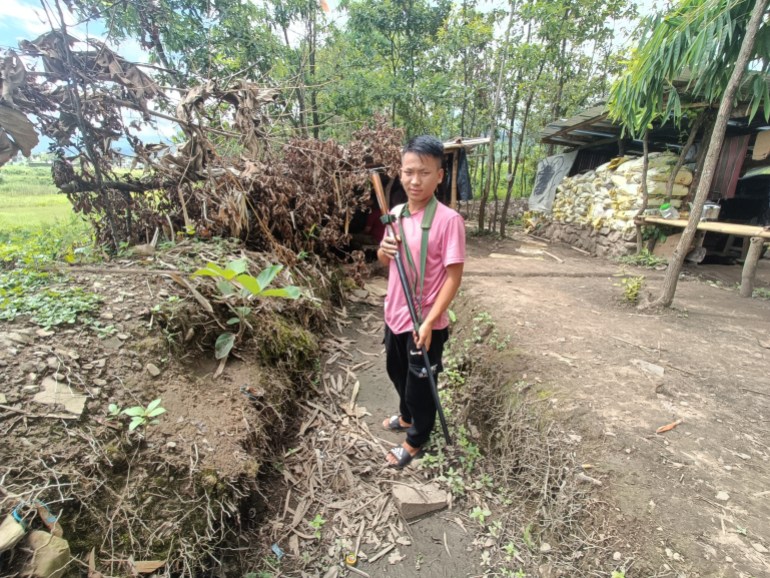
Meitei civilians in villages like Singda Kadangband additionally face an identical dilemma. The nights appear limitless, and the times are spent with unceasing uncertainty.
“Apart from the 60+-year-olds, everybody is predicted to do 24-hour shifts,” a villager who didn’t want to be named, informed me again in September. “I’ve a one-year-old child and work as a welder. I really feel scared, however we don’t have a lot alternative.”
“It will have a long-lasting influence, notably on the younger and future generations. They’ve weapons to defend their neighborhood, however that’s not precisely the way it will pan out. The individual may use it to unravel private enmity. Then some unemployed individuals may begin extortion. Then there could be circumstances of mistaken id killing after which revenge killing. It’ll turn out to be a vicious cycle,” retired Lieutenant Normal Konsam Himalay Singh informed me.
What Lieutenant Normal Singh stated had begun to play out by December once I final reported from Manipur. Movies of gun-toting males within the valley and the hills had proliferated on social media. The armed “volunteers” have been being valorised on social media whereas in private areas, many spoke of the concerns of younger males being lured or recruited by militias, spawning a unending cycle of assault, revenge and turf struggle.
That is regardless of greater than 60,000 armed personnel of the federal authorities’s paramilitary forces, the military and the state police implementing a buffer zone dividing a big a part of the state into two ethnic territories that every neighborhood fears crossing.
On April 19, Manipur will vote — together with a number of different components of the nation — even because the battle rages on between the 2 communities.
“The chief minister ought to have been thrown out. He’s the pinnacle of state, and if he can’t be trusted, … the military and police ought to have gone on overdrive and brought management over the realm, … however finally, it was allowed to proceed as a result of when it simmers, your voting combination will increase,” stated the retired police officer acquainted with the safety and intelligence operations within the area.
The second a part of this collection seems to be on the position of the drug commerce, politics and armed teams in maintaining Manipur on a boil.
Angana Chakrabarti is an affiliate member of The Reporters’ Collective.
(With inputs from Harshitha Manwani, Mohan Rajagopal, Aryan Chaudhary and Vedant Kottapalle)

